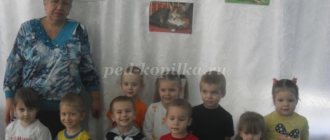Project on speech development of children on the topic: “Pets” (in the second junior group)
Transcript
1 Municipal state-owned preschool educational institution “Kindergarten 7” Project on the speech development of children on the topic: “Pets” (in the second junior group) 2022 The work was carried out by: teacher-frolova N.I.
2 Project type: educational and creative. Project participants are educators, parents, children 3-4 years old. Project duration 1 week. Relevance Currently, not everyone has the opportunity to keep pets in the house. And love for animals should be fostered in children from an early age. Therefore, the project allows children to expand their knowledge about animals kept at home and their maintenance. Environmental education shapes children's behavior and responsibility for nature. And animals are the first source of knowledge about nature. Based on ideas about animals, the child learns to see relationships in nature and act accordingly.
3 Project goal: To develop children’s knowledge about domestic animals. Project objectives: - develop the ability to listen to works of art, memorize short poems, and solve riddles. — to develop children’s interest in oral folk art, Russian folk tales about domestic animals. - develop the skill of acting together, the ability to play in a team; — intensify the educational and research activities of children, parents and teachers; — to cultivate in children curiosity and a sense of empathy for living beings;
4 Expected result. - Children will formulate the concept of pets. Children will correctly name animals and their babies. Know what they eat. How to care for them. What benefits do they bring to people? — Your cognitive interest in animals will increase and you will have a desire to take care of them. — Children’s communication and creative abilities will expand. Children's vocabulary will be enriched. — Parents will become participants in the educational process.
5 1st stage Preparatory. 1. Selection of methodological literature on the topic of the project. 2. Selection of fiction, riddles, poems on the topic “Pets.” 3. Selection of visual teaching aids, demonstration material, a set of pet toys. 4. Involve parents in working on the project: making a “Pets” model. Stage 2 is practical. Project implementation. Conducting educational activities with children on the topic of the project.
6 Cognition. Topic: “Domestic animals and their babies.” Objectives: To expand children's understanding of domestic animals and their cubs. Be able to distinguish different animals by their characteristic features. Enrich children's understanding of the behavior and nutrition of domestic animals. Introduce the role of an adult in caring for pets. Develop emotional responsiveness. Speech development. GCD. Topic: “Who is screaming?” Goals: - coherent speech: teach children to compose a short story together with the teacher; — Grammar: learn to name baby animals, form words using the suffix onok-; - dictionary: distinguish words with opposite meanings (big-small); — sound culture of speech: clarify and consolidate the correct pronunciation of the sound “and”, learn to regulate the pitch of the voice.
7 Examination of a poster, illustrations, paintings about domestic animals. Conversation “Pets”, about appearance, lifestyle, living, caring for them. Composing stories “Find out who I am?” Situational conversation “How do animals wash themselves?”, “If there were no pets?” "How I take care of pets." Word games: “Name the animal”, “Who has who?”, “Name it affectionately”, “Who screams what?” Fiction. Reading “Goat-dereza”, “Kids and the Wolf”, “Ryaba Hen”, E. Charushin “About Tyupa”, V. Suteev “Who said meow?”, “Chicken and Duckling”, S. Mikhalkov “Kittens”, E. Blaginina “Kitten”, S. Marshak “Mustachioed Striped”, V. Berestov “Hen with Chicks”.
8 Saying nursery rhymes “Like our cat.” Memorizing “I love my horse”, “Pussy, pussy, pussy scat”, “Little bull” Guessing riddles Health saving. Conversation “Wash your hands after interacting with animals” Social communicative development. D/i “Gather a family”, “Who loves what?”, “Where is my mother?”, “Who lives where?”, “Who is missing?”, “Clean up order”
9 Board games: cubes, lotto, puzzles on the theme of the project. Role-playing games: “Journey to grandma’s village.” “Family” - I was given a kitten (puppy) for my birthday. “Veterinary Hospital”, “On the Farm”. Structural and model activities: construction of “Animal Farm”, “Dog Kennel”, “Pen for Buryonka”. Watching the cartoon “A Kitten Named Woof.” Motor activity. P/n: “Cat and Mice”, “Kittens and Puppies”, “Cat and Chicks”, “Sparrows and the Cat”, “Guess by Movement”, “Fox in the Chicken Coop”. Finger gymnastics. Productive activity.
10 Drawing “Let's help the dog Bug find friends” Purpose: to practice drawing round-shaped objects using gouache using the poking method. Application: “A kennel for Sharik.” Stencils, coloring pages based on the theme of the project. Musical development. Selection of pet voices. "Little gray cat" music. V. Vitlina sl. N. Naydenova. “Dog” M. Rauchwerger.
11 Listening to the song “Who Grazes in the Meadow” music. A. Pakhmutova, lyrics. Yu. Chernykh. Interaction with family. Take part in the production of the “Pets” model. Reading works and riddles on the topic of the project to children.
12 Final stage. The result of the project. “Pets” layouts have been created. As a result of the project: 1. Children have formed and enriched their understanding of domestic animals. Children recognize animals by appearance, know where they live, what they eat, what the baby animals are called, and how to care for them. 2. Making a model made it possible to visualize the habitat of domestic animals. 3. The children’s vocabulary was expanded. 4. Children’s communication and creative abilities have expanded. 5. Children have become inquisitive, began to treat animals more carefully, and show a caring attitude towards them.
13 Thank you for your attention!
Summary of the lesson on FEMP in the second junior group “Pets”
Author: Leonova Ekaterina Alekseevna
Teacher, GBOU School No. 1905, Moscow
Summary of the lesson on FEMP in the second junior group “Pets”
Summary of the lesson on "FEMP" in the second junior group "Pets"
Goal and tasks:
- Generalization and systematization of children's knowledge about geometric shapes;
- Comparison of two objects;
- Continue to assign the name of pets;
- To train children in the ability to recognize and name pets based on their outline;
- Form ideas about geometric shapes (circle, square, triangle) and shapes of objects (round, square, triangular);
- Practice correctly naming geometric shapes;
- Continue to develop the ability to distinguish objects by color, name colors correctly;
- Activate children's speech activity;
- Foster love and respect for animals. Cultivate the desire and ability to listen to each other.
Progress of the lesson:
Surprise moment “The dog came to visit.”
Educator:
Guys, who is this knocking on our door? (a toy dog appears) The dog Tyapa came to visit us. (The teacher greets the children on behalf of the dog).
Dog:
Hello, children (children say hello) My nickname is Tyapa. Today I came to your math class, I also want to learn a lot, and I also prepared a surprise for you.
Educator:
Children, can we help the dog? Sit down, Tyapa, right here, today in class the children and I will learn to recognize and name geometric shapes, we will play different games, and at the end of the lesson we will see what kind of surprise you have prepared for us.
Educator:
Look what the dog brought us (the teacher opens the image) What is this? Yes, this is a house. Children, look at the unusual windows in the house.
Educator:
How many windows are there in the house? (children's answers) That's right, there are a lot of windows.
- Compare the windows with each other. Are they the same or different?
— How do windows differ from each other (children’s answers). That's right, the windows are of different colors: there is a blue window, red, green. They also differ in shape: there is a round window, a square window, a triangular window.
- And someone lives in the house. Do you want to know?
Didactic game “Name the geometric figure”
- Look at this window. If you correctly name the name of this geometric figure and what color it is, a window will open.
-tell me what this geometric figure is called (child’s answer) That’s right, it’s a circle. What color is the circle? (child’s answer: “the circle is red”). Look, the window has opened, which means you answered correctly. (The teacher removes the overhead circle from above)
- Who is that looking at you from the window? (children's answers) Of course, it's a cow.
- Tell me what this geometric figure is called (child’s answer) Correctly, it’s a square. What color is the square? (child’s answer: “green square”). Look, the window has opened, which means you answered correctly. (The teacher removes the overhead square from above)
- Who is that looking at you from the window? (children's answers) This is a horse.
- Look at the circle and the square. Compare them. Please tell me how they differ from each other (children's answers)
- Correct color: the circle is red and the square is green.
Drawing with your fingers in the air (or on the table) the outline of geometric shapes of a square and a circle.
- Draw a circle in the air (on the table) with your finger. Look, the finger runs in a circle, where it left and returned. Now draw a square. I point my finger straight, here’s a corner, turn my finger, point down, another corner, etc. What does a square have (the teacher points to the corners? That’s right, a square has corners. Does a circle have corners? (child’s answer) A circle has no corners , it can roll. Can a square roll? Why? That's right, because the corners interfere with it.
- Hoe, you see, a circle differs from a square in that it does not have corners, but a square does. What smart and smart kids!
In a similar way, children name other geometric shapes and animals in these windows, compare a triangle and a circle.
— How many animals live in the house? ("a lot of")
- How can you call all these animals in one word? (children's answers) That's right - pets.
Educator: The dog is tired, she wants to play with you. Stand up, pull up your chairs, stand behind the back of the chair.
Dynamic pause – “Make the move” game
Educator
: The game is called “Make the Move.” If I say the word:
- circle - you clap your hands,
- square - stomp your feet,
- triangle - jump on two legs.
- Guys, tell me, if I say square, what will you do? (children reinforce the rules of the game)
Educator:
You played great! The dog liked the way you played. They sat down beautifully with their back straight and their legs together. Well done!
Working with handouts. Game exercise “Compare animals by height”
Educator:
And now, pets from the house will appear on your tables if you close your eyes. Don’t peek (the teacher gives each child a flat image - figurines of a cow and a horse). Open your eyes. You have figurines of pets on your table. Place them in front of you.
Educator:
Name the animals you have? (answers)
— The horse and the cow argued which of them was taller. What needs to be done to find out who is taller (children's answers). That's right, you need to put the horse next to the cow on the same line and compare them with each other or put them next to each other.
Educator:
Attach the cow figurine to the horse figurine, so that their legs are on the same line. (Or place the cow and horse on the table next to each other)
- Who is taller, a cow or a horse? (children’s expected answers: “a horse is higher than a cow”) (“a cow is lower than a horse”)
- Children, show with your finger which horse is tall. Remember...we run our finger from the bottom of the horse's legs up to the head or from top to bottom. That's how tall the horse is.
- Show with your finger which cow is short... We draw our finger from the bottom of the cow’s legs up to the head or from top to bottom. That's how low the cow is.
— Tell me, how tall is the cow? (“low cow”)
- Tell me, how tall is the horse? (“high horse”)
- Children, take the tall animal in your right hand.
- Which hand is your horse in?
- Take the low animal in your left hand.
-Who is in your left hand?
- Why do you have a horse in your right hand? (because she's tall)
Educator:
Great job! The dog remembered everything.
Educator:
Tell me, what did you and I learn to do in class today?
- What did we do?
- The dog really liked it. She watched you very carefully, the dog tells me in my ear (the teacher brings the toy to his ear) that you are so great! If you complete all the tasks correctly, the dog will show you other pets for this!
Project in the second junior group “Pets and Birds”
Project in the second junior group “Pets and Birds”
Project participants:
teachers, parents, children of the “Wizards” group
Objective of the project:
enriching and deepening children’s ideas about domestic animals and poultry, and how to care for them.
Project objectives:
— to form children’s knowledge about domestic animals and birds, taking into account the integration of educational areas.
- cultivate love and caring attitude towards pets.
- develop skills in writing descriptive stories.
- develop children’s productive activities, improve their skills in drawing, sculpting images of domestic animals and birds; develop creative abilities;
— develop the ability to communicate with peers during gaming activities;
— develop cognitive activity, thinking, imagination, communication skills;
— teach children how to communicate properly with pets;
— to cultivate a caring attitude and love for animals, feelings of empathy for all living things, and the ability to make basic conclusions and conclusions.
Project type:
short-term, cognitive and creative.
Project duration
-2 weeks.
Problem.
Looking at pictures of domestic animals and birds, the children were unable to answer the questions: “What are baby animals called?”, “Who lives where?”, “Who takes care of them?”, “What do they eat?”, “What benefits do they bring to humans?” ?. The children did not have sufficient knowledge. Therefore, there was a need to work on the “Pets and Birds” project in order to deepen and enrich the knowledge of students.
Relevance
Currently, not everyone has the opportunity to keep pets in the house. And love for animals should be fostered in children from an early age. Therefore, the project allows children to expand their knowledge about animals and birds kept at home and their maintenance. Environmental education shapes children's behavior and responsibility for nature. And animals are the first source of knowledge about nature. Based on ideas about animals, the child learns to see relationships in nature and act accordingly.
Expected result:
—
Children will formulate the concept of domestic animals, poultry, children will correctly name animals and their young, know what they eat, how to care for them, what benefits they bring to people, know their place of residence (
kennel, pigsty, cowshed, chicken coop
) .
—
Your cognitive interest in animals will increase and you will have a desire to take care of them.
—
Children's communication and creative abilities will expand. Children's vocabulary will be enriched.





